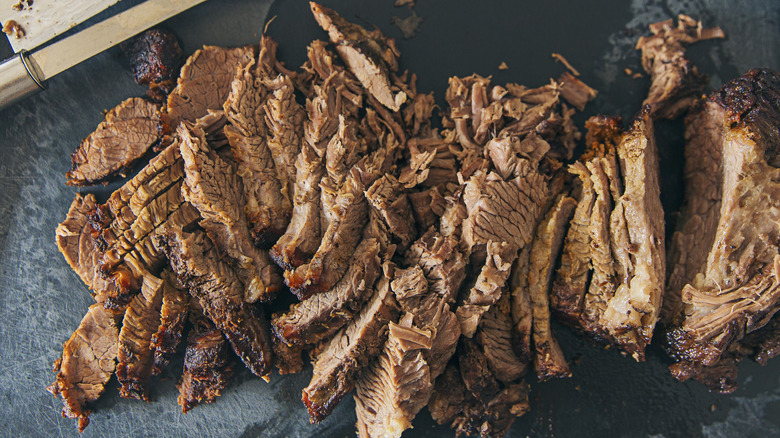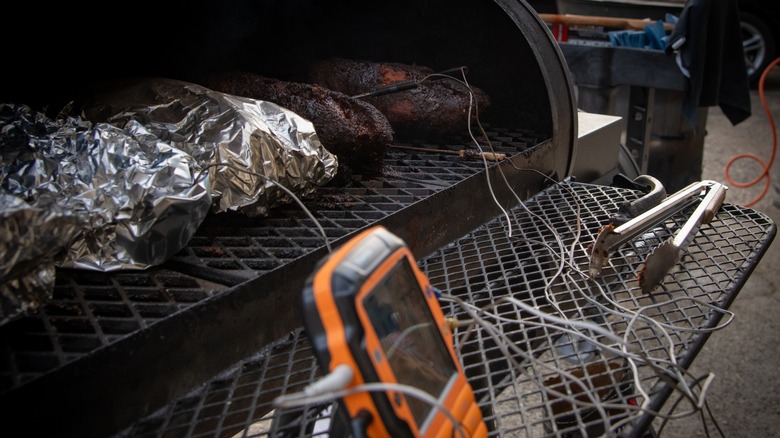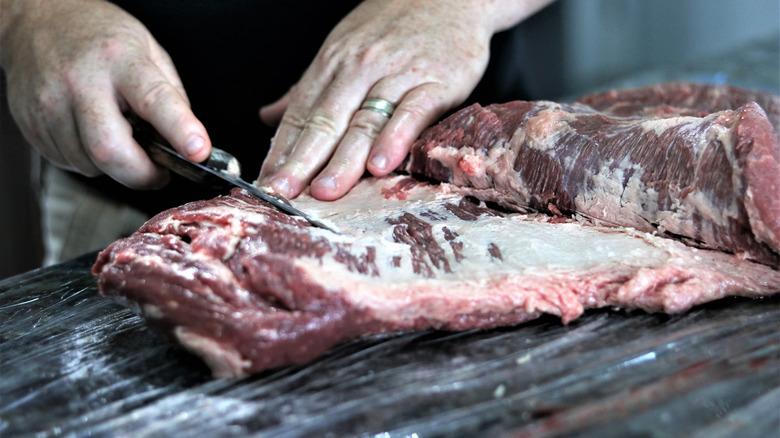The BBQ Blunder That Ruins Brisket
Brisket may not be the best cut of beef to cook on the grill, but when it's smoked over a wood fire, it's practically perfect. Well, as long as you have sufficient patience. Smoking brisket takes a long, long time, possibly an entire day or more, and many a brisket has been sabotaged by a cook who's too eager to move things along. Scott Thomas, who blogs about his favorite cooking method at GrillinFools, told The Takeout, "The biggest mistake with brisket is not being patient during the stall."
So what's a stall? According to Thomas, it's the point where the cooking temperature hits a plateau: "Many hours into the cook, the temp will flatline for multiple hours. It's maddening." He went on to warn: "Brisket beginners are tempted to raise the temp of the grill to power through the stall. The reason this is bad is they can quite easily power through their desired final temp."
Some people take their brisket off the smoker at 190 degrees Fahrenheit, although this works best with wrapped meat that can finish cooking in the trapped residual heat. Thomas' preferred temperature is 200 degrees, although he feels the meat can go up as high as 205 degrees and still be okay. He cautioned, however, "Raise the temp on the grill to get through the stall faster, and you could be looking at 220 degrees Fahrenheit before you know it. Also, that lovely dark bark can go from the tastiest part of the meat to burnt in a heartbeat."
Wrapping a brisket can help save it from disaster
Wrapping your brisket before it goes in the smoker can help keep it from overcooking. One way to do so is to use aluminum foil, a tool that Scott Thomas refers to as the "Texas crutch." He says an even better option is to use peach butcher paper (which is actually more pink than orange). It differs from regular white butcher paper in that it's not bleached and is also less rigid. The reason why paper makes a better brisket wrap, Thomas explained, is "because it is porous and will breathe, thus keeping the bark in better shape than foil."
If you choose to wrap your meat, Thomas advises doing so after it's been smoking for a few hours. As he told us, "The whole point of cooking meat low and slow is to break down the connective tissue without burning the outside and drying the meat out ... [Wrapping] will allow the brisket to steam in its own juices, which will hyper-accelerate the breakdown of those connective tissues without drying out the brisket." To make the meat even moister and more flavorful, you can coat the paper with bacon fat or tallow. "I've had great results with this method," said Thomas.
Not trimming the brisket is also an issue
Yet another way you can set yourself up for a brisket fail is by neglecting to trim it the right way. It's usual for excess fat to be trimmed, but Scott Thomas endorses cutting away some of the lean meat, as well. As he explained, "The problem with brisket is, it is two distinct muscles. The point, which is thick and well marbled with fat, and the flat, which is flat and not that well marbled. It's very hard to get the flat to be done at the same time as the point."
In fact, he warned that any extra-thin parts of the flat will cook so fast that they will get rock hard and crunchy. For this reason, he recommends that you trim them away before cooking, saying: "I know it will feel like a waste to toss that in the trash, but it's going to be way overcooked before the rest of the brisket, so it's getting tossed in the trash either way."


